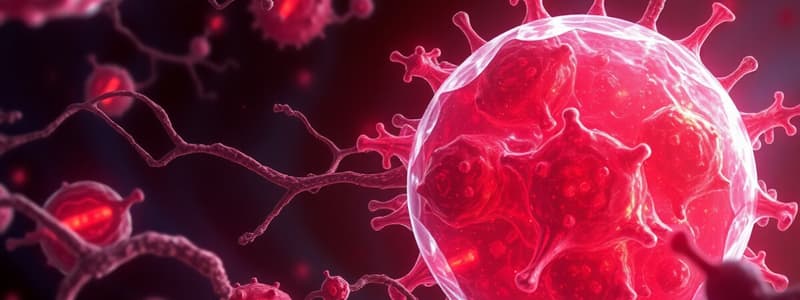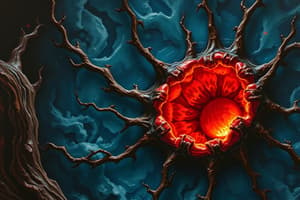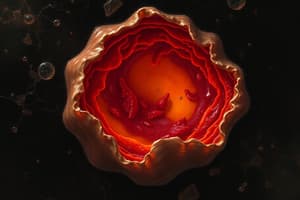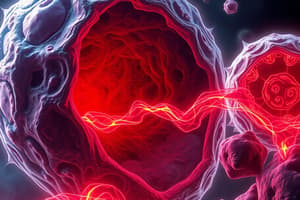Podcast
Questions and Answers
What morphological feature is NOT associated with necroptosis?
What morphological feature is NOT associated with necroptosis?
- Nuclear fragmentation (correct)
- Cell swelling
- Retention of integral nucleus
- Membrane rupture
Which process involves the formation of double membraned vesicles for cellular components?
Which process involves the formation of double membraned vesicles for cellular components?
- Autophagy (correct)
- Apoptosis
- Ferroptosis
- Necrosis
Which method is NOT used to detect necroptosis?
Which method is NOT used to detect necroptosis?
- MLKL
- RIPK3
- Cytochrome c release (correct)
- RIPK1
What is a characteristic of cell shrinkage in apoptosis?
What is a characteristic of cell shrinkage in apoptosis?
Which of these cell death types is characterized by the inhibition of inflammation?
Which of these cell death types is characterized by the inhibition of inflammation?
Which type of cell death is driven by lipid peroxidation?
Which type of cell death is driven by lipid peroxidation?
Which detecting method is associated with autophagy?
Which detecting method is associated with autophagy?
What is a distinguishing feature of apoptosis compared to necroptosis?
What is a distinguishing feature of apoptosis compared to necroptosis?
What initiates the extrinsic pathway of apoptosis?
What initiates the extrinsic pathway of apoptosis?
Which protein is involved in the formation of the death-inducing signaling complex (DISC)?
Which protein is involved in the formation of the death-inducing signaling complex (DISC)?
What is the role of caspase-8 in the extrinsic apoptosis pathway?
What is the role of caspase-8 in the extrinsic apoptosis pathway?
What option refers to a protein that blocks the extrinsic pathway of apoptosis?
What option refers to a protein that blocks the extrinsic pathway of apoptosis?
In which pathway is caspase-9 typically utilized?
In which pathway is caspase-9 typically utilized?
What feature is characteristic of apoptosis?
What feature is characteristic of apoptosis?
How does Bid contribute to apoptosis?
How does Bid contribute to apoptosis?
What is the final outcome of caspase activation in apoptosis?
What is the final outcome of caspase activation in apoptosis?
What is the main consequence of oxidative stress in cellular injury?
What is the main consequence of oxidative stress in cellular injury?
Which organ is the most susceptible to ischemia injury?
Which organ is the most susceptible to ischemia injury?
What role does intracellular calcium play in cell injury?
What role does intracellular calcium play in cell injury?
Which compartment has the highest concentration of calcium in a normally functioning cell?
Which compartment has the highest concentration of calcium in a normally functioning cell?
What is a cellular response to decreased perfusion in less susceptible tissues?
What is a cellular response to decreased perfusion in less susceptible tissues?
How does the ubiquitination status of RIPK1 influence cellular response?
How does the ubiquitination status of RIPK1 influence cellular response?
What is the significance of polyunsaturated fatty acids in the context of ischemia?
What is the significance of polyunsaturated fatty acids in the context of ischemia?
Which receptors are associated with the recognition of pathogens and play a role in the immune response?
Which receptors are associated with the recognition of pathogens and play a role in the immune response?
What is the primary characteristic of liquefactive necrosis in the brain or spinal cord?
What is the primary characteristic of liquefactive necrosis in the brain or spinal cord?
Which term describes the macroscopic appearance of necrosis in the brain and spinal cord?
Which term describes the macroscopic appearance of necrosis in the brain and spinal cord?
What is the most common cell type affected by hypoxia or ischemia leading to necrosis?
What is the most common cell type affected by hypoxia or ischemia leading to necrosis?
Which form of gangrene occurs when the necrotic tissue becomes infected by bacteria?
Which form of gangrene occurs when the necrotic tissue becomes infected by bacteria?
What type of necrosis is typically associated with aspiration pneumonia in the lungs?
What type of necrosis is typically associated with aspiration pneumonia in the lungs?
What initiates the necrosis process in parenchymal tissue of the brain?
What initiates the necrosis process in parenchymal tissue of the brain?
What eventually happens to glial cells during the progression of necrosis in the brain?
What eventually happens to glial cells during the progression of necrosis in the brain?
In the case of gas gangrene, what type of bacteria is typically involved?
In the case of gas gangrene, what type of bacteria is typically involved?
What characterizes the histological appearance of necrotic adipocytes?
What characterizes the histological appearance of necrotic adipocytes?
What is one of the main causes of gangrenous mastitis in the ewe?
What is one of the main causes of gangrenous mastitis in the ewe?
What type of necrosis is characterized by firm and nodular adipose tissue with off-white chalky deposits?
What type of necrosis is characterized by firm and nodular adipose tissue with off-white chalky deposits?
Which type of gangrene typically shows a clear line of demarcation between necrotic and viable tissue?
Which type of gangrene typically shows a clear line of demarcation between necrotic and viable tissue?
What type of necrosis occurs mainly in peripancreatic adipose tissue?
What type of necrosis occurs mainly in peripancreatic adipose tissue?
Which of the following is NOT associated with fat necrosis?
Which of the following is NOT associated with fat necrosis?
What type of necrosis is the cause of ischemic necrosis in the distal aspects of the hind limbs?
What type of necrosis is the cause of ischemic necrosis in the distal aspects of the hind limbs?
Which statement accurately describes the appearance of the skin overlying necrotic mammary tissue in wet gangrene?
Which statement accurately describes the appearance of the skin overlying necrotic mammary tissue in wet gangrene?
Flashcards are hidden until you start studying
Study Notes
Cell Death Mechanisms
- Apoptosis is a programmed cell death that involves a series of biochemical events leading to a controlled demolition of the cell.
- Necroptosis is a programmed cell death characterized by cell swelling, membrane rupture, and a translucent cytoplasm with moderate chromatin condensation.
- Autophagy is a highly conserved catabolic process involving the formation of double-membraned vesicles called autophagosomes that engulf cellular proteins and organelles for delivery to the lysosomes.
- Ferroptosis is a form of regulated cell death triggered by iron-dependent lipid peroxidation that is inhibited by glutathione peroxidase 4.
Detecting Methods for Cell Death Mechanisms
- Apoptosis: DNA fragmentation, cytochrome C release
- Necroptosis: RIPK1, RIPK3, MLKL
- Autophagy: Immune colloidal gold technique, GFP-LC3
- Ferroptosis: ATPG3, immunofluorescence
- Pyroptosis: BCA, Ca2+ fluorescence, spectral analysis
Types of Cell Death and Inflammation
- Non-lytic Cell Death: Oxeiptosis and apoptosis do not induce inflammation.
- Lytic Cell Death: Pyroptosis induces and spreads inflammation.
Extrinsic Apoptosis Pathway
- Initiated by alterations in the extracellular milieu.
- Binding of a ligand to a cell surface death receptor leads to the formation of a death-inducing signaling complex (DISC).
- DISC activates caspase-8.
- Caspase-8 activates effector caspases, such as caspase-3 and caspase-7, leading to cell death.
Key Players in the Extrinsic Apoptosis Pathway
- FLIP: An inhibitory protein that blocks the extrinsic pathway by binding to procaspase-8 without activating it.
- XIAP: Blocks the extrinsic pathway by inhibiting caspase-3 activation.
Reperfusion Injury
- Reperfusion injury is a complex phenomenon that results from restoration of blood flow to ischemic (oxygen-deprived) tissue.
- Oxidative stress, calcium imbalance, and opening of the mitochondrial permeability transition (MPT) pore are key contributors to reperfusion injury.
Necrosis and Apoptosis: Role in Tissue Injury
- Necrosis: A form of cell death that occurs when cells are injured in a way that overwhelms their ability to repair themselves.
- Apoptosis: Essential for normal tissue development and homeostasis.
- Coagulative Necrosis: Leads to a firm, opaque area of tissue.
- Liquefactive Necrosis: Leads to the formation of a soft, liquefied area of tissue.
- Gangrenous Necrosis: A form of tissue death that typically occurs in distal extremities.
- Fat Necrosis: A form of necrosis that occurs specifically in adipose tissue.
TNF Receptor 1 (TNFR1) Signaling
- TNFR1 is a key receptor involved in the regulation of cell death and inflammation.
- Upon ligation of TNFR1, a cell can respond in three different ways depending on the ubiquitination status of RIPK1.
- TNFR1 signaling can result in apoptosis, necroptosis, or cell survival.
Studying That Suits You
Use AI to generate personalized quizzes and flashcards to suit your learning preferences.




